ASRock's High-End Vision 3D 252B HTPC Review
by Ganesh T S on May 7, 2012 6:15 AM EST- Posted in
- Home Theater
- Sandy Bridge
- HTPC
- GT 540M
- NVIDIA
The ASRock Vision 3D 252B is basically a notebook solution. It wouldn't make sense to compare it with full blown desktop Sandy Bridge solutions (or for that matter, any system with a power consumption of more than 100W). In the comparative benchmarks provided in the rest of this review, we will provide the scores obtained by the Vision 3D 252B and other similar SFF HTPC solutions.
Windows Experience Index
This metric is often considered meaningless, but we feel it serves as an indicator of what could be the bottleneck in a system for pre-built HTPCs. With such a premium configuration, the only letdown is the absence of a SSD, and it is duly reflected in this index with the primary hard disk weighing in at 5.9.
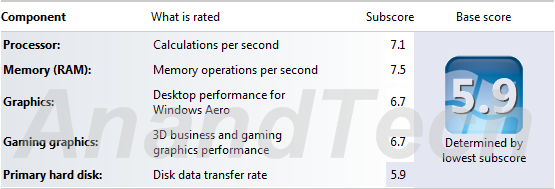
Using a SSD as the primary disk is the only thing that could have been done in order to improve this score.
Miscellaneous Performance Metrics
The graphs below give an idea of where the ASRock Vision 3D 252B stands with respect to performance when compared with other SFF HTPCs.
PCMark Vantage's PCMark score gives a general idea of the system's capability.
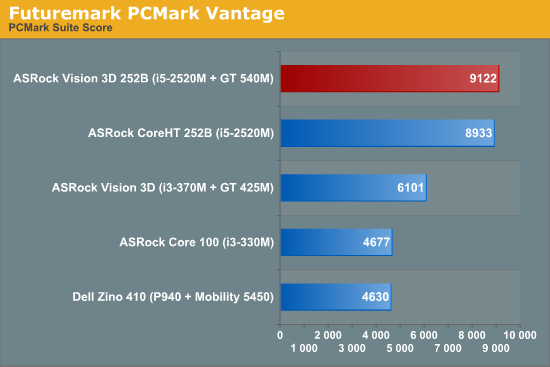
We also ran the 3D Mark Vantage and 3D Mark 06 benchmarks and the graphs below show how the GT 540M (in conjunction with the Core i5-2520M) fares when compared to the graphics capabilities of other pre-built SFF HTPCs.
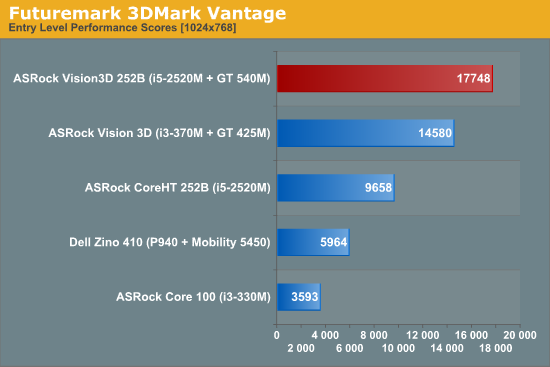
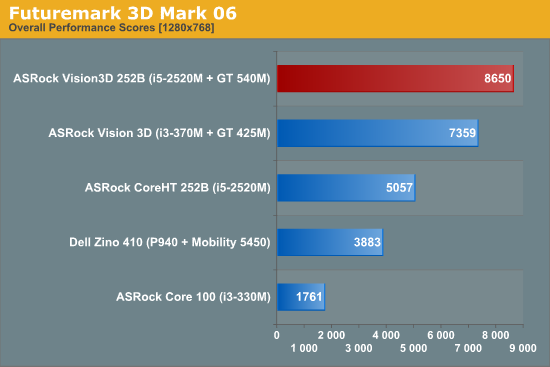
The Vision 3D 252B is miles ahead of the SFF HTPCs from last year. This goes on to prove that the bar for the high-end HTPC just keeps getting higher.
In addition to the above synthetic benchmarks, a couple of common HTPC workloads were also benchmarked. We have some data on the x264 encoding performance using the i5-2520M. Note that we are unable to utilize QuickSync for this test because QuickSync is unable to provide any for of support for accelerating x264 encode. As expected, the results match what was obtained in the CoreHT 252B review.
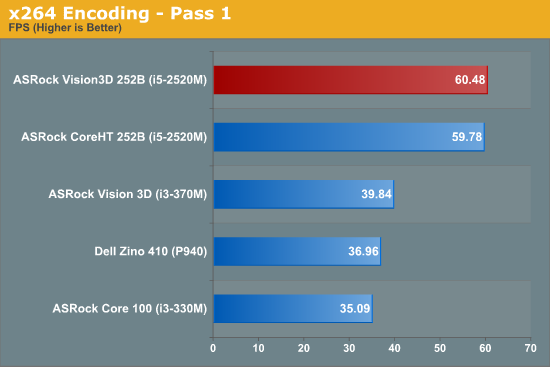
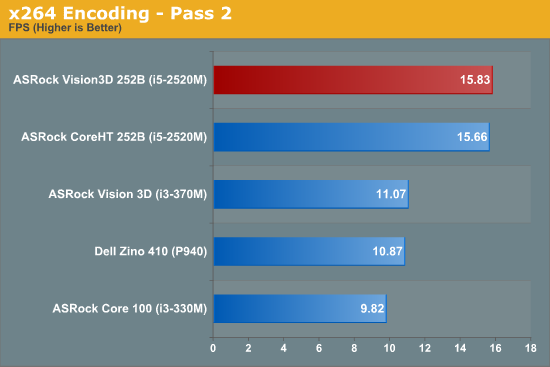
An estimate of how well WinRAR performs, particularly with respect to processing split archives, wraps up this section. To evaluate this, we take a 4.36 GB MKV file, compress it in the 'Best' compression mode into a split archive (97.1 MB each), which results in 44 files on the hard disk. The time taken to decompress this split archive is then recorded. The performance in this benchmark is heavily influenced by the hard disk in the system. It looks like both the hard disk characteristics of the Vision 3D 252B are the same as that of the CoreHT 252B.
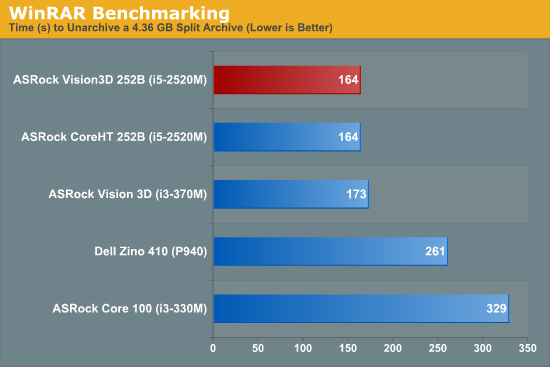
We have deliberately refrained from dealing with gaming benchmarks in this review. Instead, we will focus on very HTPC-centric benchmarks over the next few sections. For readers interested in finding out how the GT 540M fares in gaming bencmarks when coupled with a mobile Sandy Bridge processor, I suggest taking a look at Dustin's gaming benchmarks prepared as part of a notebook review. Though Dustin doesn't have kind words for the GT 540M, note that the Vision 3D 252B is definitely a step up from the first generation Vision 3D (for which we have gaming benchmarks here).










60 Comments
View All Comments
jabber - Monday, May 7, 2012 - link
I bought about a dozen of the first generation Atom boxes and they are all still trucking and the customers still love them.I still want one for myself.
TerdFerguson - Monday, May 7, 2012 - link
For what they were meant for, the little ION machines were flipping fantastic. With a package price of below $200 for everything but the OS, it's a value proposition that hasn't been matched by anything since.duploxxx - Monday, May 7, 2012 - link
yes there are but not all OEM have the guts to do it right and just stuff garbage onto consumers. If they love it means they have never used anything else...http://www.anandtech.com/show/4442/zotac-zbox-braz...
BPB - Monday, May 7, 2012 - link
Am I the only guy who goes to the bottom of the specs sheet first and looks fir price? This thing is way too much for an HTPC.duploxxx - Monday, May 7, 2012 - link
what would you expect if you see following specs...Intel Sandy Bridge Core i5-2520M
(2 x 3.00 GHz (3.20 GHz Turbo), 32nm, 3MB L2, 35W)
Graphics NVIDIA GT 540M (1 GB VRAM)
1 reason why you would need these 2 parts into a HTPC, can be replaced by 1 APU which cost less and consumes less in total, end of story.
BPB - Monday, May 7, 2012 - link
I am not saying it isn't worth it. I am saying I see HTPC in the review title, look at the price, and think it's not worth reading the article. Simply can't see spending that on an HTPC, that's all. It is not a knock on the product. I'd be very happy owning this.cknobman - Monday, May 7, 2012 - link
Agreed.Over $1000 for a HTPC and then with these specs to boot?
Im not saying the specs are bad but they are certainly not worth of over $1000.
mbzastava - Monday, May 7, 2012 - link
I recall reading a nice comment from the Intel NUC article which points out how this new form factor is just repackaged laptop parts whith a nice new profit margin. I couldn't agree with him more.The question you should be asking is: Why does this unit cost around $1000 when you could get a similarly specced laptop for almost $300 less?
ganeshts - Monday, May 7, 2012 - link
Economy of scale - How many such HTPCs are going to be purchased vs. how many laptops the vendor would sell.blackbrrd - Monday, May 7, 2012 - link
I just use a laptop as a HTPC. You can get a decent laptop for waaay less than this costs, and you can use it as a laptop if you need one.